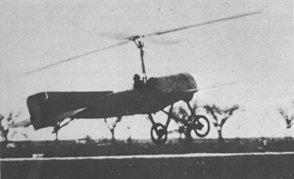Autogyro
An autogyro, also known as a gyroplane, is a type of rotorcraft that uses an unpowered rotor in free autorotation to develop lift. Forward thrust is provided independently, typically by an engine-driven propeller. While similar to a helicopter in appearance, the autogyro's rotor is not powered during flight, and it relies on the forward motion to generate airflow through the rotor blades, which in turn produces lift.
History[edit | edit source]
The autogyro was invented by the Spanish engineer Juan de la Cierva in the early 1920s. De la Cierva's first successful autogyro, the Cierva C.4, made its maiden flight in 1923. The development of the autogyro was a significant milestone in the history of aviation, providing a safer alternative to fixed-wing aircraft and early helicopters, which were prone to stalling and other aerodynamic issues.
Design and Operation[edit | edit source]
Autogyros typically feature a fuselage, a rotor system, and a propulsion system. The rotor system consists of a set of blades mounted on a central hub, which rotates freely. The propulsion system, usually a piston engine or a turboshaft engine, drives a propeller that provides the necessary forward thrust.
The key to the autogyro's operation is the phenomenon of autorotation. As the autogyro moves forward, air flows upward through the rotor blades, causing them to spin and generate lift. Unlike a helicopter, the rotor is not powered by the engine during flight, which simplifies the mechanical design and reduces the risk of mechanical failure.
Advantages and Disadvantages[edit | edit source]
Autogyros offer several advantages over other types of aircraft. They are generally simpler and less expensive to build and maintain than helicopters. They also have excellent short takeoff and landing (STOL) capabilities, making them suitable for use in confined areas.
However, autogyros also have some limitations. They typically have lower top speeds and shorter range compared to fixed-wing aircraft and helicopters. Additionally, they require forward motion to generate lift, which means they cannot hover in place like a helicopter.
Modern Use[edit | edit source]
Today, autogyros are used for a variety of purposes, including recreational aviation, aerial photography, agricultural spraying, and law enforcement. Advances in materials and technology have led to the development of modern autogyros that are more reliable and efficient than their early counterparts.
See Also[edit | edit source]
References[edit | edit source]
External Links[edit | edit source]
Navigation: Wellness - Encyclopedia - Health topics - Disease Index - Drugs - World Directory - Gray's Anatomy - Keto diet - Recipes
Search WikiMD
Ad.Tired of being Overweight? Try W8MD's physician weight loss program.
Semaglutide (Ozempic / Wegovy and Tirzepatide (Mounjaro / Zepbound) available.
Advertise on WikiMD
WikiMD is not a substitute for professional medical advice. See full disclaimer.
Credits:Most images are courtesy of Wikimedia commons, and templates Wikipedia, licensed under CC BY SA or similar.Contributors: Prab R. Tumpati, MD





